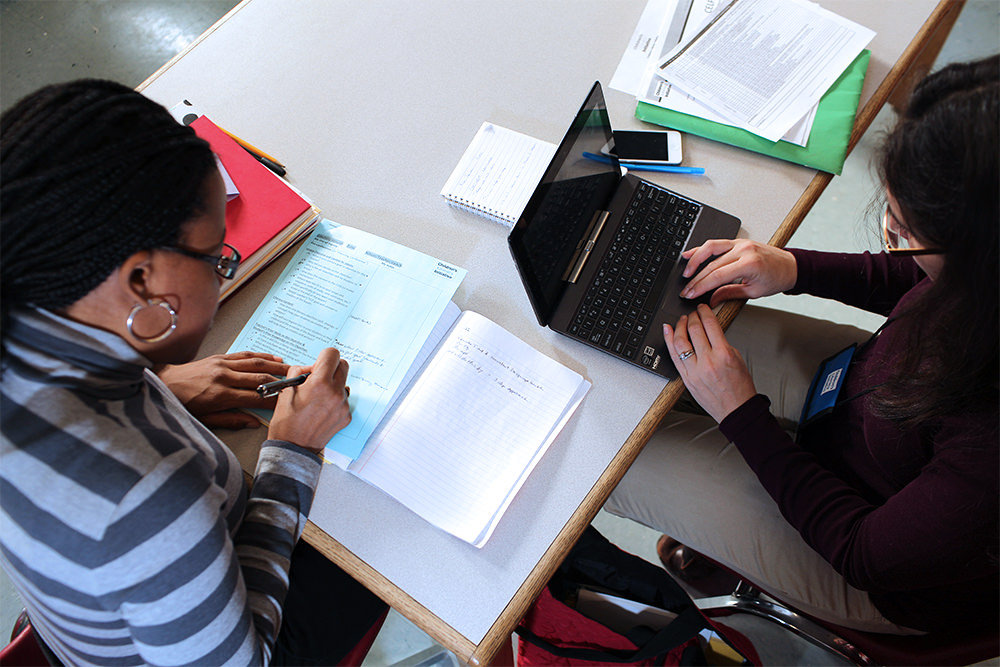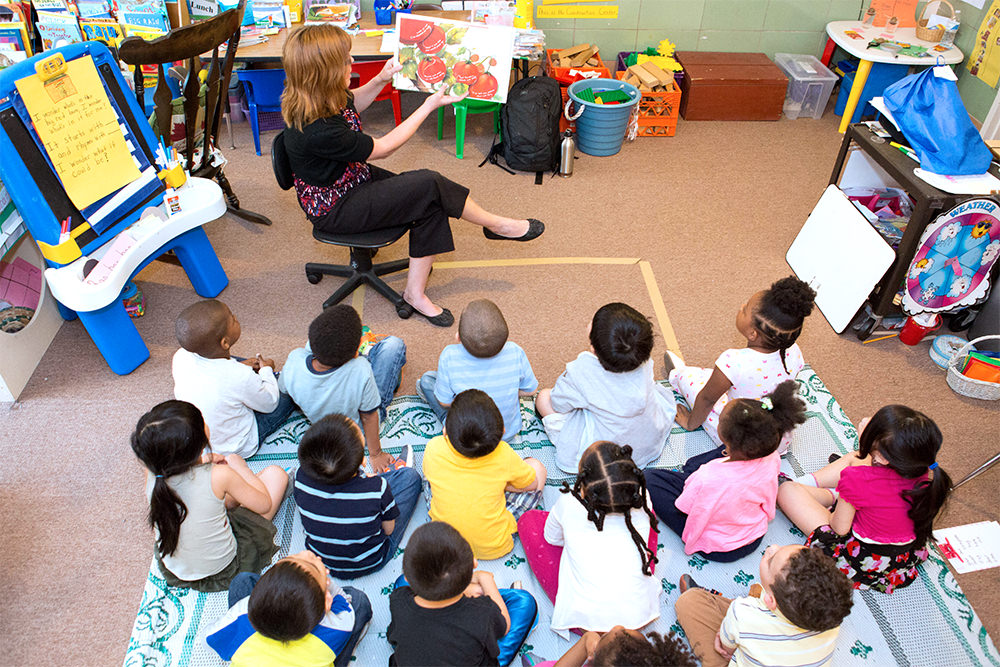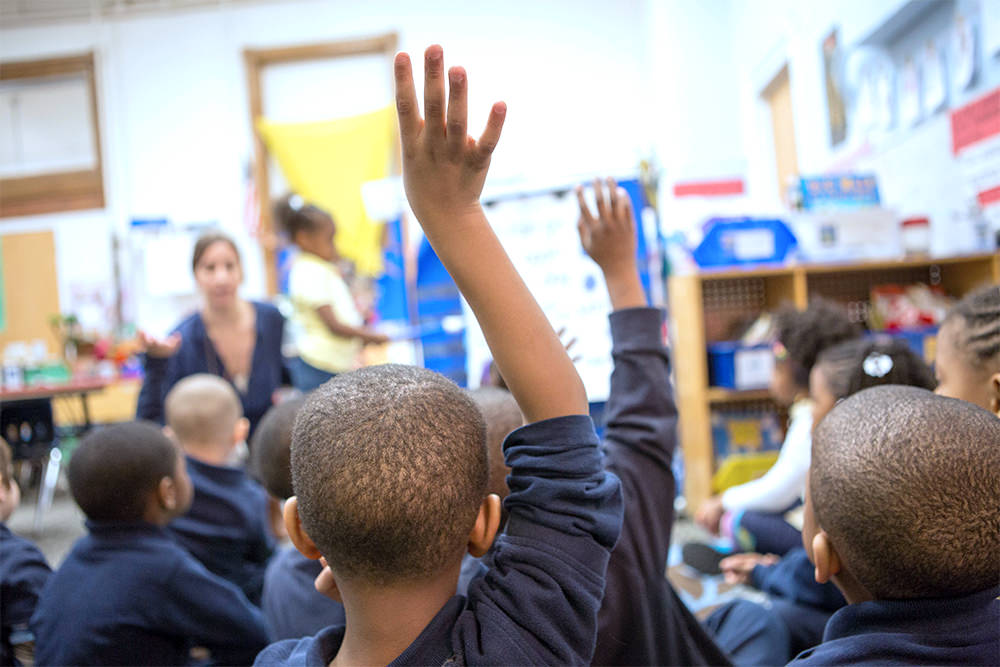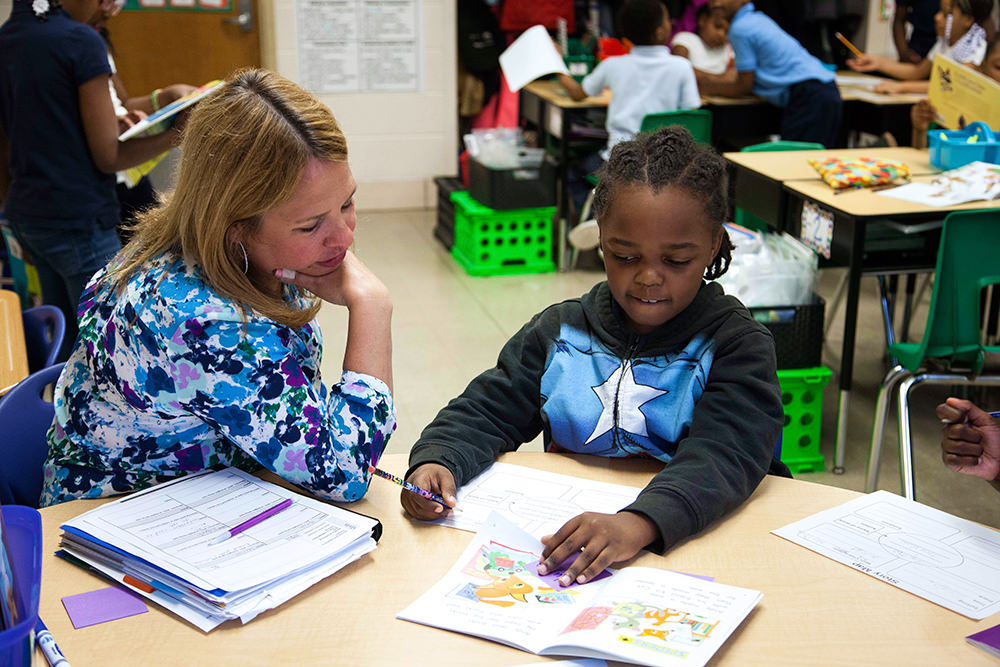Getting Started with Reading Workshop
Ready to get started? Here are the first steps you can take to build, change, or enhance this instructional practice in your classroom.
Choose a primary literacy objective based on children’s needs, standards, and curriculum scope and sequence.
Consider all of the relevant factors when determining an objective, such as standards, grade level curriculum scope and sequences, and formative assessment data (e.g., anecdotal notes and running records). The objective will need to be appropriate for the majority of the class. Thoughtful selection of the primary learning objective results in instruction that is more focused, meaningful, and engaging for the children, resulting in greater overall literacy learning. Create a productive language outcome to align with your literacy objective.
- Review the reading standards and scope and sequence for your grade level to inform the primary literacy objective choice.
- Gather and review formative assessment data (e.g., running records and anecdotal notes) on your children and consider this information, too.
- Draft an objective that will best meet the instructional needs for most of the children in the class. Review and revise as needed.
- Consider how the objective can be addressed in other instructional practices in your the literacy block
- Consider how you will measure your individual children’s outcomes with this objective.

Use a lesson planning template to guide the thoughtful planning and pacing of the lesson and rehearse the language.
The lesson planning template is a valuable tool in preparing a successful lesson. It is equipped with helpful prompts that focus your attention and support your thinking through the planning process of each lesson component. The lesson planning template includes space to facilitate scripting out the actual language that you will use during various parts of the lesson. It prompts you to consider the language supports you will need to make sure your language learners are successful as well. The lesson template ensures that instruction is purposeful and productive for all your learners.
- Consider how you will teach the lesson to reach the variety of learners in your class.
- Gather all of the lesson materials (e.g., picture books, word cards, and sentence strips) and formative assessment data.
- Follow the prompts to complete the planning template. Reflect and revise the lesson as needed.
- Rehearse the language for the lesson.
- What considerations and/or scaffolds will be necessary to help your language learners be successful?
- Where will you touch base with your children’s social-emotional needs by reviewing an element of classroom culture?
Develop procedures that promote choice, independence, and active engagement.
Reading Workshop is heavily dependent upon the children’s ability to carry out routines independently. They must be able to self-select books, read and write independently, work with partners and groups, locate resources, and maintain a sufficiently low noise level to enable everyone to work undisturbed. Through a series of carefully planned procedural lessons (e.g., “How to Pick a Just Right Book” and “How to Partner Read”) and well-placed anchor charts, children become active and responsible members of the workshop community.
- Plan and teach the series of procedural lessons necessary for Reading Workshop over time.
- Co-create anchor charts in the procedural lessons and place them where they are needed to remind the children of the procedures. Include photos or illustrations on the anchor charts to support the children in reading them.
- Role play, rehearse, and practice the routines and procedures.
- Support the children in self-monitoring and self-regulating with child-friendly rubrics.
- Allocate a brief portion of the share time at the end of the workshop to reflect upon how well the children carried out the routines and procedures.
Create a joyful climate around learning to read.
Create an attractive large group meeting area with a colorful rug and comfortable seating. Make your classroom library irresistible with picture book covers that all face out, posters of favorite book characters, and comfy chairs. Engage the children in rituals, songs, and chants that help to build and enhance the feeling of community. When we teach children to read, one of the most important lessons we convey is that reading is fun. If they don’t believe that reading is fun, they won’t put in the time, effort, and persistence necessary to become fluent readers. The climate that we create in our classrooms also greatly contributes to the children’s motivation to learn how to read.
- Infuse songs, chants, and cheers into your workshop rituals. Call the children to the rug with a song. Use songs to remind them of their responsibilities. Celebrate their learning with cheers.
- Maintain colorful, comfortable, and kid-size small group and large group reading areas.
- Celebrate children’s successes individually in conferences and with the whole community during share time.
- Focus on progress, not perfection. Look for all of the ways children are approximating skilled reading and nudge them along.
- Share your enthusiasm for reading. Talk about your own reading life and interests.
- Provide opportunities for your children to self-reflect on their progress as readers.
Gather children in close proximity.
 Gather the children in close proximity for reading mini-lessons in the whole group meeting area. You will sit facing the children, who are seated in rows on the rug. The children should always have a clear view both of you and of any instructional materials that you might be using (e.g., pocket chart, white board, and picture book.) The children might have regular seats on the rug (e.g., next to their “turn and talk” partners). Many classroom rugs already have individual seating areas. If yours does not, you can designate spots on the rug with colored tape. Teach procedural lessons to help the children learn and remember how to come to rug, how to sit on the rug, and how to carry out the instructional routines used in mini-lessons, such as “turn-and-talk.” Co-create anchor charts on procedures and post them in the large group meeting area where they are visible to the children.
Gather the children in close proximity for reading mini-lessons in the whole group meeting area. You will sit facing the children, who are seated in rows on the rug. The children should always have a clear view both of you and of any instructional materials that you might be using (e.g., pocket chart, white board, and picture book.) The children might have regular seats on the rug (e.g., next to their “turn and talk” partners). Many classroom rugs already have individual seating areas. If yours does not, you can designate spots on the rug with colored tape. Teach procedural lessons to help the children learn and remember how to come to rug, how to sit on the rug, and how to carry out the instructional routines used in mini-lessons, such as “turn-and-talk.” Co-create anchor charts on procedures and post them in the large group meeting area where they are visible to the children.
- Create a whole group meeting area in your classroom where the children can gather for reading mini-lessons.
- Designate certain spots for children who would benefit from sitting in the front during lessons.
- Assign specific spots on the rug to children who would benefit from sitting next to each other.
- Assign turn and talk partners, so that the children can share ideas and practice strategies during the lesson.
- Position the white board, pocket chart, or any other instructional resource that you will use in a place where all the children can see it.
- Consider the social-emotional needs of your children during whole group lessons and individual’s ability to attend or stay focused for extended periods of time.
Explain the lesson objective in child-friendly language.
All mini-lessons are driven by a primary literacy objective. Begin and end your mini-lesson by explicitly stating the objective (the “what”) and telling the children how it will help them as readers and writers (the “why”). Use specific, yet simple, language that makes the primary literacy objective clear. Be thoughtful about the language you use to ensure that your language learners can fully participate in the lesson. Use scaffolds such as visual aids or sentence frames to support your explanation. You might prepare a sentence strip with the objective written on it and post the sentence strip in the meeting area. Provide examples as needed for additional support. Explicitly referring to the primary literacy objective of the lesson helps the children to focus on it and to describe the skill or strategy that they should later walk away with and try in their own reading or writing.
- When planning your lesson, take time to “translate” the primary learning objective to child-friendly language.
- Locate and prepare examples of the teaching point to share with the children. For example, if you want to teach the children about reading dialogue, show a big book with evident dialogue.
- Write the objective on the white board or a sentence strip to post in the meeting area.
- Start the mini-lesson by clearly stating the objective and telling the children how the skill or strategy will help them as readers, writers, thinkers and speakers.
- End the mini-lesson the same way it started, by repeating the primary literacy objective.
Offer children a clear explanation about when and how they might apply the teaching point in their independent reading.
 The Reading Workshop mini-lesson is purposeful and informed by standards, school district curricula, and the children’s instructional needs. It is important for the children to know how the lesson will support their growth as readers. Each mini-lesson contains a have-a-go segment and a linking segment. The have-a-go segment is where the children have the opportunity to try out the skill or strategy, sometimes for the very first time. The linking segment is where you explain to the children how they might use the skill or strategy during independent reading. For example, you might say, “When you read today you might notice quotation marks in your book, when you do, now you know that a character is talking. These quotation marks tell you exactly what words the character is saying.”
The Reading Workshop mini-lesson is purposeful and informed by standards, school district curricula, and the children’s instructional needs. It is important for the children to know how the lesson will support their growth as readers. Each mini-lesson contains a have-a-go segment and a linking segment. The have-a-go segment is where the children have the opportunity to try out the skill or strategy, sometimes for the very first time. The linking segment is where you explain to the children how they might use the skill or strategy during independent reading. For example, you might say, “When you read today you might notice quotation marks in your book, when you do, now you know that a character is talking. These quotation marks tell you exactly what words the character is saying.”
- Script the language you will use to explain to the children how they will apply the teaching point in their independent reading.
- Model the skill or strategy for the children, and then let them have a go.
- Based on your observations during the have-a-go segment, choose one or two children who have something constructive to share and call on them to do so.
- During the linking segment of the mini-lesson, emphasize how the teaching point can be applied to help them become better readers.
- Provide explicit expectations to guide children’s independent work.
- During Independent Work Time, highlight children who are applying the teaching point in their independent reading.
- During share time, encourage children to share how they use the teaching point.
Conduct a mini-lesson in less than 15 minutes.
The Reading Workshop mini-lesson is usually the “first order of business.” The importance of its role cannot be overemphasized. The lesson is structured to gradually release responsibility to the children, transitioning directly into work time, during which the children practice and apply the skill or strategy that was taught in the mini-lesson. Be mindful of the time constraint. The power of mini-lessons is that they are purposeful, precise, and targeted. The prescribed time for the mini-lesson takes the children’s attention span and stamina into account, so that important lesson points will not be lost because the children have become distracted due to fatigue. Remember that you will be able revisit the teaching points during Guided Reading and individual conferences. Additionally, keeping your mini-lesson under 15 minutes ensures that the bulk of Reading Workshop time is devoted to children reading.
- Carefully plan and script the reading mini-lesson.
- Rehearse the mini-lesson while watching the time to ensure that you can teach the lesson within the allotted 15 minutes.
- Be sure to keep all of the lesson materials accessible and within reach, so that you don’t lose any time searching for items.
- Limit questions from the children. The mini-lesson should focus on direct instruction.
- Carefully consider how you will model the teaching point. If you are using a text, use a familiar one so the children already know the plot. Pinpoint which part of the book actually supports your teaching point and just focus on that section rather than trying to read an entire book, which almost always leads to exceeding the allotted time.
Teach children what reading time looks like, sounds like, and feels like.
A powerful procedural lesson that synthesizes the children’s responsibilities during work time is the “looks like, sounds like, feels like” lesson. The centerpiece of this lesson is the co-creation of an anchor chart. You will lead the children in reflecting upon what work time will look, sound, and feel like when it is working well. This procedural lesson is the culmination of all the other procedural lessons that you have taught, and it provides the children with concrete and comprehensible descriptors.
- Use the procedural planning template to plan the “looks like, sounds like, feels like” lesson.
- Within the context of the lesson, co-create the anchor chart.
- Ask the children what the classroom should look like during work time. They will mention children reading in the library, partners reading together, children listening to books in the listening center, etc. Record these points on the anchor chart under the heading, “Reading Workshop Looks Like …”
- Go through the same procedure for “sounds like” (pages turning, partners reading to each other in soft voices, etc.) and “feels like” (happy, comfortable, peaceful, relaxing, fun, etc.).
- Post the anchor chart in a place where the children can see it.
- Reread and review it before workshop time and as needed.
Individualize instruction by conferencing with children.
 The individual reading conference is one of the most productive ways to collect information about a child’s reading and language. It also gives you some insight into the effectiveness of your teaching. An individual conference gives you an up-close look at a child’s reading habits, interests, processes, and strategies in action. Time is allocated in the workshop block to meet with individual children. In an average five minute conference, you will have a conversation with your child about something s/he is reading. Offer the child specific praise and teach one thing that will help this child become a more skilled reader or language user. Information about the conference is recorded in your reading assessment binder. This information is used to track children’s progress, plan small group instruction, and inform whole group needs.
The individual reading conference is one of the most productive ways to collect information about a child’s reading and language. It also gives you some insight into the effectiveness of your teaching. An individual conference gives you an up-close look at a child’s reading habits, interests, processes, and strategies in action. Time is allocated in the workshop block to meet with individual children. In an average five minute conference, you will have a conversation with your child about something s/he is reading. Offer the child specific praise and teach one thing that will help this child become a more skilled reader or language user. Information about the conference is recorded in your reading assessment binder. This information is used to track children’s progress, plan small group instruction, and inform whole group needs.
- Prepare an assessment binder with a section for each child in the class.
- Schedule time in the workshop block to meet with individual children. Create a monthly calendar to make sure you meet with each child on a regular basis.
- Have the child read to you from a book in his/her book baggy or a Guided Reading book. If the book comes from the book baggy, this reading will confirm that the book baggy contains “just right” books for the child.
- Have a conversation (not a quiz!) about the book. This gives you information about the child’s comprehension and language strengths and needs.
- Use this time to support children both as a speakers and learners of English as well as readers.
- Make a teaching point. Use running records, anecdotal notes, and the oral reading that the child has just completed to identify a partially developed skill or strategy. Then demonstrate it and have the child try it out.
- Record notes from the conference in your binder.
Facilitate share sessions that solidify children’s learning.
Workshop concludes with share time. The children reconvene to the large group meeting area and can bring along the books or response journals that they will use if they are selected to share. Start share time by reiterating the teaching point. Then invite children to share their experiences with applying the teaching point to their independent reading, to something they learned as readers, or to something about being a reader in the classroom reading community. Recognize and celebrate children who stayed focused and on task during workshop time. Share time lasts for approximately five minutes. End the share time by making the teaching point one final time.
- Call the children to the large group meeting area. Remind them to bring the journals, writings, and books that they want to share.
- Preselect no more than three children to share, based on your observations of these children during work time.
- Remind the children of the teaching point and call upon the preselected children to share one at a time.
- Briefly address classroom culture issues that occurred during workshop and recognize the children who stayed on task.
- Let the children think about and talk about what they practiced or learned during workshop time.
- End the workshop by restating the teaching point.

Comments (26)
Log in to post a comment.